Why potato juice is good for hair and how to use it correctly
Want to keep your hair fresh and clean for as long as possible, easy to comb and look well-groomed? No, this is not an advertisement for expensive products, but the result of using potato masks at home. The availability of ingredients and the ease of preparation of products will bring every woman closer to the cherished dream of gorgeous hair.
The content of the article
Why potato juice is good for hair
To restore the beauty and health of hair, the fair sex turn to expensive cosmetics for help. Few people know that a similar effect can be achieved at home using a simple and affordable product - potatoes.
The usefulness and effectiveness of a vegetable is due to its chemical composition. The tubers contain almost the entire B complex, including folate and niacin, which are essential for hair health and growth. Also molybdenum and chromium are present in potatoes, which help to strengthen them. Protein and lysine repair damaged and porous hair.
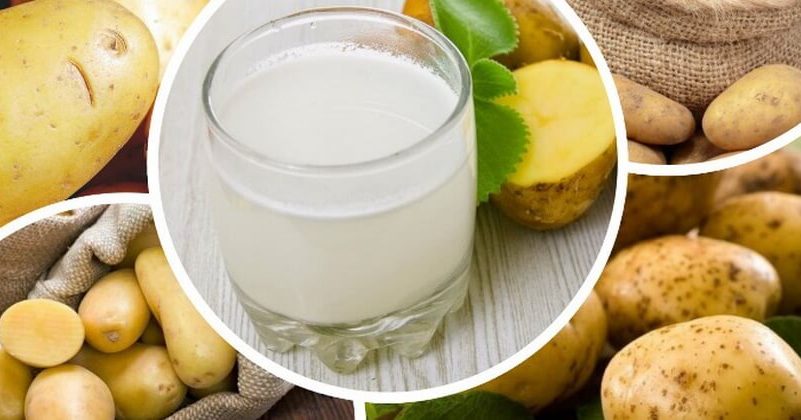
The result will not be long in coming if you include potato masks in your weekly care. Among the useful properties of tubers:
- protection of colored hair from color loss;
- regeneration of the upper layer of the epidermis;
- deep nutrition and restoration of hair follicles and hair along the entire length.
In home cosmetology use the juice from the tuber, but peel and gruel are also helpful. Every woman can choose the best recipe for herself.
For reference. As a bonus, the intervals between shampoos will increase.
Indications for use
Potato-based products are effective for:
- malfunctions of the sebaceous glands;
- overdried ends, faded hair;
- inflammatory processes.
Germinating or green tubers contain solanine (a toxic organic compound), so it is best not to use them for masks. Lying potatoes will also not be beneficial.
Best masks with potatoes
A homemade potato head mask is a great alternative to purchased skin care products. Potato masks are suitable for all hair types, hypoallergenic. They go well with herbal infusions, dairy products, cosmetic oils.
For reference... For oily scalp, a potato mask is best done with an infusion of chamomile or calendula. Sea buckthorn, burdock and olive oils are suitable for normal skin.
For hair growth
The mask according to this recipe enhances hair growth, makes them manageable and elastic. The following ingredients are required for cooking: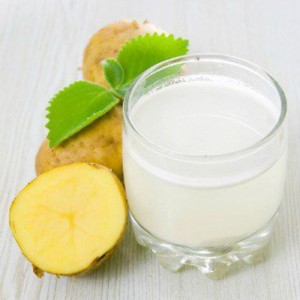
- potatoes - 1 pc.;
- chopped horseradish root - 2 tbsp. l .;
- olive oil - 3 tbsp. l .;
- burdock oil - 1 tbsp. l .;
- sandalwood oil - 3 drops;
- egg yolk - 2 pcs.
Mask preparation process:
- Grate potatoes and horseradish on a fine grater.
- Add pre-beaten yolks to the mass.
- Bring the olive and burdock oils to + 40 ° C in a water bath and combine with the vegetable base.
- Add sandalwood oil and stir.
Apply the mask to dry hair in the root zone, wrap your head with cling film or put on a plastic bag and warm with a towel. After 15 minutes, wash your hair with shampoo.
Attention! Do not use the mask for wounds or cracks in the skin.
For split ends
This mask is used for loss of shine and elasticity of hair, split ends, as well as for profuse hair loss and recovery after a hot summer.
Components: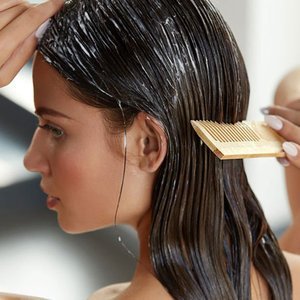
- boiled potatoes - 100 g;
- cream - 4 tbsp. l .;
- brewer's yeast - 10 g;
- jojoba oil - 2 tbsp. l .;
- patchouli oil - 5 drops.
Mask preparation:
- Boil potatoes in their uniform, peel, chop until mushy.
- Allow to cool slightly, then add cream and jojoba oil.
- Dissolve brewer's yeast in 2 tbsp. l. water, add to the total mass, and then drip patchouli oil.
Apply the mask to damp hair along the entire length. Wrap with cling film and a towel. Keep for at least an hour, then wash off with shampoo.
"Potato water"
Peel 5-6 tubers pour the required amount of water. Bring to a boil, then simmer the broth over low heat for at least 30-40 minutes to obtain a concentrate. Then cool and drain. Rinse your hair after shampooing 2-3 times a week. After several applications, it will become noticeable that the hair has become strong and shiny, gray hair will gradually decrease.
For reference. It is better not to use potato water for blondes. This can lead to a change in their natural color or darkening of bleached curls.
For oily hair
For oily scalp, it is best to use oil-free recipes. The mask is based on potato juice. For cooking you need:
- Grind raw potatoes (2 pcs.) On a fine grater, squeeze out the mass.
- 5-6 st. l. combine the resulting potato juice with kefir or yogurt (250 ml).
- Spread the mask over clean, damp hair. Wash off after half an hour without using shampoo.
Dairy products can be substituted for honey and egg white. Mix the juice from 2 raw potatoes, add 1 tbsp. l. honey and 1 protein whipped to peak. Apply to head, wrap with foil and towel. Wash off after 40 minutes with warm water.
Potato juice with butter

You can add liveliness and shine to your hair using this recipe. Ingredients:
- potato juice - 6-7 tbsp. l .;
- burdock, castor or olive oil - 1 tsp;
- honey - 1 tsp;
- sea or table salt - 1 tsp;
- yolk - 1 pc.
Mix all ingredients and apply to hair and scalp. Wrap the top with cling film and a warm towel. Keep it for 30 minutes, then wash your hair with shampoo.
Potato peelings
In this recipe, the peel saves from gray hair, acting as a natural and mild coloring due to the starch present in potatoes. Ideal for brown-haired women. On darker hair, the result will be almost imperceptible; this method can darken blondes.
In addition to painting over gray strands, the product has a beneficial effect on the condition of the scalp and hair, prevents dryness and hair loss.
Cook the peelings of 5 potatoes over low heat for half an hour. Strain and use as a rinse after shampooing.
How to properly apply potato hair masks
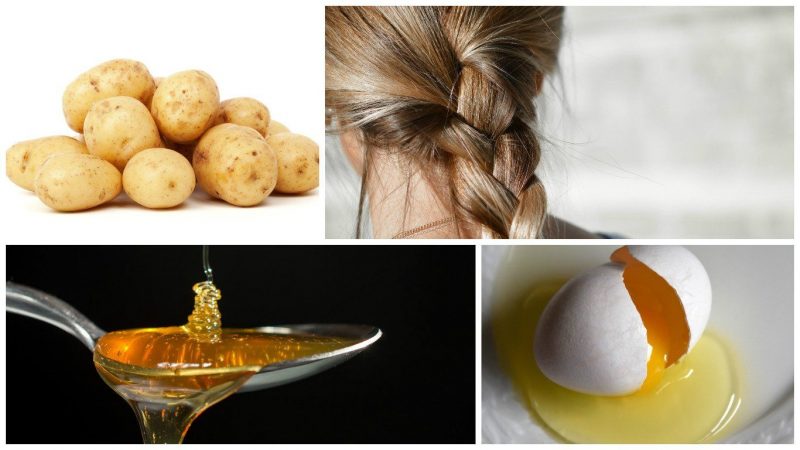
Get the most out of treatment the rules for using hair masks at home will help:
- Masks made from natural products have a short shelf life, so the mixture must be prepared immediately before use.
- It is best not to use young potatoes due to their low starch content.
- Apply the mask to clean and damp hair.
- For dry scalp, use the product once a week, for oily scalp - 2-3 times.
- If the mask contains oil, it is advisable to warm it up before use.
- Start applying the mixture from the roots, then spreading it along the entire length.
- Movements should be soft, massaging.
- For better penetration of nutrients, it is recommended to wrap your head with a special cellophane cap and a terry towel.
Reviews
Women of different ages use potato masks to heal split ends and paint gray hair, and most of them are satisfied.The only exceptions are blondes - potato juice darkens blond strands.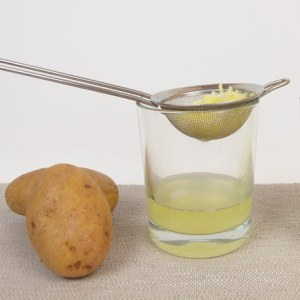
Alevtina, 48 years old: «From the age of 16 I have been using potato face masks on the advice of a beautician. I need gruel, but I always poured out the juice. Recently I came across an article about hair masks, I decided to try it. I will say that I was delighted. Such a penny, but what a result. The hair is manageable and shiny. And I also noticed that they are easier to style. I definitely recommend it! "
Marina, 35 years old: “I noticed that I was starting to turn gray. I was terribly upset, because I really love my natural color (dark blond). I don’t want to use paint in principle, I started looking for an alternative. They advised to rinse hair with potato broth. I probably use 3-4 weeks, the gray hair is camouflaged. "
Alla, 24 years old: "I found a recipe for a potato mask for split ends, my hair became just silk. The only negative for me is that the hair is darkened by about one tone. I'm blonde, and I'm not entirely happy with that. I will look for a replacement. "
Read also:
What is the calorie content of potatoes and do they get fat from it?
Is it possible to eat green potatoes, is it dangerous for the body
Conclusion
How to achieve silky hair, adjust the balance between oily roots and brittle ends? How to remove gray hair on your head? With potatoes, these questions disappear by themselves.
Homemade masks from tubers do not cause allergies, are suitable for all types of hair, do not require a lot of time at a minimum cost. Simple and pleasant procedures have no contraindications.